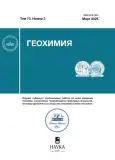Том 70, № 3 (2025)
- Год: 2025
- Выпуск опубликован: 15.03.2025
- Статей: 6
- URL: https://journals.eco-vector.com/0016-7525/issue/view/13613
- DOI: https://doi.org/10.31857/S0016-7525703
Статьи
Реконструкция характеристик исходного расплава многофазной клинопироксенит-габбронорит-диоритовой интрузии Кааламо (Северное Приладожье, Южная Карелия)
Аннотация
Палеопротерозойский раннеорогенный массив Кааламо расположен в юго-восточной части Раахе-Ладожской зоны – зоны стыка архейского Карельского кратона и протерозойского Свекофеннского орогена. Массив трехфазный, 1-я фаза представлена перидотитами, оливиновыми клинопироксенитами, габбро; 2-я фаза – габброноритами; 3-я фаза – диоритами, тоналитами и плагиогранитами. Для метаперидотитов, метапироксенитов и габброидов Кааламского комплекса представлены новые данные по петрохимии, геохимии и составам породообразующих минералов. Эти данные использованы в программе COMAGMAT–3.75 для термодинамических расчетов траекторий равновесной кристаллизации представительных пород и средних составов первой и второй фаз внедрения. Результаты расчетов обработаны по методу геохимической термометрии, что позволило получить оценку температуры (~1220 °С) и вероятного состава исходного высокомагнезиального расплава (~9.5 мас. % MgO, оливин с 84 мол. % форстерита). Сравнение этого примитивного расплава с модельными составами дифференциатов и петрогеохимическими характеристиками подтверждает образование пород первой и второй фаз внедрения из единого источника, что согласуется со схожим распределением РЗЭ в этих породах, а также результатами изучения Sm–Nd изотопной системы, которые указывают на общий мантийный источник пород. При этом установлено, что расчетные порядки кристаллизации минералов хорошо согласуются с распространенностью перидотитов и оливиновых пироксенитов, указывая на равновесие примитивного расплава с клинопироксеном и ортопироксеном, находящихся в перитектических отношениях с оливином. Наиболее дифференцированные породы первой фазы внедрения характеризуются появлением котектического плагиоклаза, содержащего около 80 мол. % анортита. Породы второй фазы внедрения представляют более дифференцированный материал, отвечающий габброноритовой ассоциации кумулусных фаз без оливина, но с появлением титаномагнетита на поздних стадиях кристаллизации. Сравнение модельных и реальных составов минералов указывает на систематическое смещение наблюдаемых составов оливина и пироксенов в железистую область, что является следствием взаимодействия ранних минералов кумулуса с остаточным интеркумулюсным расплавом. Изученные породы по возрасту и петрохимическим особенностям сходны с интрузиями никеленосного пояса Финляндии, что открывает перспективы для корреляций магматических событий в межрегиональном масштабе.
 189–213
189–213


Термодинамический анализ окисления сплава NixFe1–x
Аннотация
Для широко распространенного в серпентенизированных ультрабазитах аваруита Ni3Fe и других (Ni–Fe)-фаз проведен термодинамический анализ окисления NixFe1–x в широком интервале температур (400-1873 К) и коровом давлении (до 2 Кб). Получено, что фугитивность кислорода fO2 равновесия γ(NixFe1–x)-оксиды железа находится в диапазоне NNO–IW. Для γ(NixFe1–x) с мольной долей железа х ≥ 0.5 фугитивность кислорода приближается к буферу IW. Реакция камасита α(Ni0.05Fe0.95) с кислородом близка к буферным реакциями IW–IМ. Фугитивность кислорода, при которой сохраняется аваруит при T = 400–600 К не превышает ∆QFM = –7.8 ÷ ÷ –5.2, для T > 1000–1200 K – ∆QFM = –2.7 ÷ –2.0. Полученные аппроксимации температурной зависимости фугитивности кислорода могут быть использованы для оценки редоксусловий для малосульфидных систем с участием NixFe1–x в условиях земной коры.
 214-226
214-226


Изотопно-фракционные характеристики органического вещества осадков моря Лаптевых (область сиповых полей)
Аннотация
Для изучения трансформации органического вещества (ОВ) в морских осадках в процессе восходящей диффузии газов в районах сипов в море Лаптевых был исследован фракционный состав ОВ в сочетании с его изотопным составом. ОВ, извлеченное из морских осадков, было разделено на пять фракций (гексановую, гексан-бензольную, бензольную, бензол-метанольную, асфальтены) с использованием растворителей возрастающей полярности. Было показано, что разрушение асфальтенов приводит к обогащению бензол-метанольной фракции изотопно-легкими компонентами. Значения δ13C бензол-метанольной фракции были значительно ниже значений δ13C фракций асфальтенов, что связано с накоплением бактериальной биомассы в колонке осадков, через который проходил восходящий поток метана. ОВ на различных горизонтах осадка в сиповых зонах можно отнести к одному из двух кластеров в соответствии со значениями δ13C бензольных фракций ОВ. Центр первого кластера находился в поверхностном слое (около 10 см) морских осадков. Центр второго кластера находился в более глубоком слое осадков. Разница в изотопном составе углерода между центрами кластеров составляла 2–3 ‰. Использование изотопно-фракционных характеристик ОВ морских осадков позволило лучше понять биологические процессы, связанные с диффузией газа в области сипов арктических морей.
 227-237
227-237


Кинетика образования углеводородов в осадочном чехле субдуцирующей плиты
Аннотация
На основании опубликованных данных об оценке температуры поверхности субдуцирующей плиты и скорости ее погружения, а также кинетического спектра аквагенного органического вещества проведено расчетное моделирование кинетики образования углеводородов в осадочном чехле субдуцирующей плиты. Показано, что наступление пика главной фазы нефтеобразования (ГФН) в условиях субдукции происходит на глубинах 12.6–23.2 км, при температурах 147.6–179.4 °С и требует 0.1–6.4 млн лет. Разброс оценок глубин, температур и времени достижения пика главной фазы нефтеобразования определяется вариативностью угла и скорости субдукции, а также температурного градиента в опубликованных моделях. Оценка глубин и температур для образования углеводородов в осадочном чехле субдуцирующей плиты выше, чем для обстановок осадочных бассейнов кайнозоя, мезозоя и палеозоя, а интервал времени, требуемый для нефтеобразования – короче. Можно предполагать, что формирование скоплений жидких углеводородов, образованных органическим веществом осадочной оболочки субдуцирующей плиты маловероятно, при этом есть определенные перспективы для формирования залежей сухого газа.
 238–246
238–246


Физико-химические механизмы образования концентрически-полосчатых агатов в базальтах: гипотезы и эксперименты
Аннотация
На основании литературных данных суммированы основные свойства агатов и условия их образования, а также выполнен критический анализ гипотез образования агатов. Наиболее адекватной оказалась гипотеза послойного осаждения и раскристаллизации кремнезема, извлеченного из вмещающей породы (в частности, базальта). Однако остались трудности в объяснении перемещения SiO2 от вмещающего базальта к агатовым полостям, причин осаждения SiO2, роли фазовых превращений и механизма образования полосчатости. Для прояснения этих вопросов выполнены эксперименты по растворению образцов базальта в воде в течение 4 мес. при 300 °С. Образование кремнезема было заметным лишь в опытах, где образец базальта был погружен в воду наполовину. В частности, в порах и на поверхности образца выше уровня воды отложился аморфный кремнезем (опал-А), который образовал агатоподобные слоистые текстуры и местами заместился халцедоном. Результаты экспериментов объясняются в рамках дистилляционной гипотезы, которая может быть пригодной и для образования агатов. Гипотеза совмещает возможности переноса SiO2 в области низких концентраций и осаждения SiO2 в области высоких концентраций, а также объясняет полосчатость агата колебанием баланса поставки и потребления растворенного кремнезема в реакциях осаждения и фазовых превращений.
 247-263
247-263


Хроника
Идеи академика А. П. Виноградова о развитии экологической геохимии в 70-е годы прошлого столетия
 264-268
264-268









